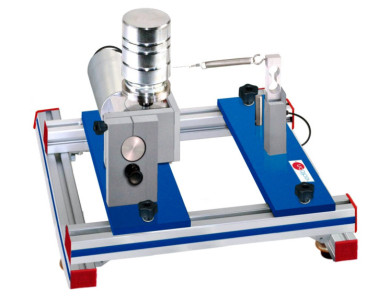MCD Thin Cylinder Unit
INNOVATIVE SYSTEMS
The Thin Cylinder Unit, "MCD", allows the study of the stress and strain in a thin wall cylinder under internal pressures.
Expansions
Laboratories
RELATED NEWS
General Description
The Thin Cylinder Unit, "MCD", has been developed to enable the student to verify various analytical formulae with actual measured results. Strain gauges mounted in various positions and orientations on the cylinder provide an opportunity for students to interpret the strains and stresses for a biaxial stress system.
Means are provided in the unit to relieve the cylinder of all longitudinal stress, so that Poisson's Ratio and Young's Modulus for the cylinder material may be accurately determined.
The Thin Cylinder Unit is supplied with a hand operated oil pump.
There is a piston located axially in the thin wall cylinder. It is drilled to suit a pressure gauge and a high pressure resistant flexible rubber hose that connects the hand operated pump to the unit. Besides, this piston has an in-built pressure relief valve and oil from the relief valve returns to the pump reservoir by means of a flexible tube.
The travel outwards is limited by caps.
The cylinder unit, which rests on the four pins, is located axially and supported on a frame by fixed stop and adjustable stop. When the adjustable stop is screwed out, the pressurized oil in the cylinder forces the piston against the caps. When the stop is screwed in, it forces the piston away from the caps and the axial load is taken on the frame, thus relieving the cylinder of all longitudinal stress. Pure axial load transmission from cylinder to frame is ensured by the hardened steel balls located at each end of the cylinder.
Six active strain gauges are attached to the cylinder to record strains generated.
Exercises and guided practices
GUIDED PRACTICAL EXERCISES INCLUDED IN THE MANUAL
- Study of rigidity in the elastic range. Hooke’s law and determination of the modulus of elasticity E in an aluminum alloy.
- Indirect strain due to Poisson’s effect. Poisson’s ratio (ν).
- Study of strain under uniaxial application of force. Mohr’s circle.
- Study of strain under biaxial application of force. Mohr’s circle.
SIMILAR UNITS AVAILABLE
SUPPLEMENTARY EQUIPMENT
Belt Friction Unit
Friction Study Unit
Journal Bearing Unit
Tribology Modular Unit
Drive Unit for Tribological Tests
Radial Pressure Distribution in a Journal Bearing
Dynamic Friction of a Cylinder on a Roller
Dynamic Friction of a Pin on a Disc
Rolling Friction in Wheels
Elastohydrodynamic Lubrication
Friction Vibration
Unit for Studying Bearing Friction
Quality

AFTER-SALES SERVICE

 Cookie preferences
Cookie preferences


















